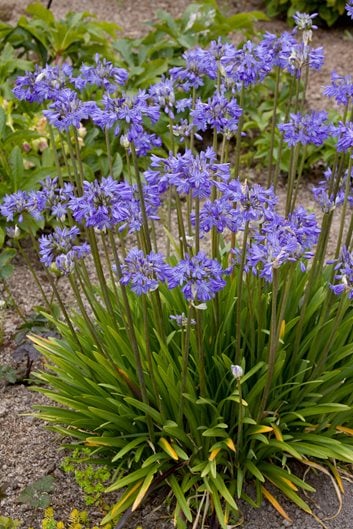How to Plant and Maintain Agapanthus in Your Yard
How to Plant and Maintain Agapanthus in Your Yard
Blog Article
Understanding the Art of Agapanthus Treatment: Essential Actions for Healthy And Balanced Development and Vibrant Blossoms
In the realm of gardening, the growing of agapanthus stands as a rewarding undertaking for those who look for to nurture these stylish flowering plants. From selecting the ideal selection to understanding trimming methods, the trip in the direction of cultivating thriving agapanthus plants is diverse and holds the vital to unlocking the complete potential of these agricultural gems.

Picking the Right Agapanthus Variety

When picking the ideal Agapanthus selection for your yard, think about factors such as climate suitability, bloom color, and development habit. Additionally, consider the environment in your region to make certain the Agapanthus range you select can flourish in your particular conditions. Recognizing the development behavior of different Agapanthus varieties is crucial for appropriate placement within your garden.
Ideal Growing Conditions
Thinking about the optimal ecological needs is necessary for successful Agapanthus cultivation. Agapanthus grows in well-draining soil with a somewhat acidic to neutral pH degree. When planting, choose a place that receives full sunlight to partial color. In hotter climates, offering some afternoon color can prevent scorching of the fallen leaves. Agapanthus plants are delicate to cold temperature levels and ought to be secured from frost throughout wintertime months.
To guarantee healthy and balanced development and lively blossoms, plant Agapanthus light bulbs at a depth of regarding 2-4 inches and area them 8-12 inches apart. Mulching around the base of the plants assists keep moisture and reduces weed growth.
Watering and Fertilizing Tips
Preserving appropriate dampness degrees and offering crucial nutrients are essential elements in the treatment program for Agapanthus plants. When it comes to watering Agapanthus, it is crucial to strike an equilibrium. These plants choose continually damp soil but are at risk to root rot if overwatered.
Fertilizing Agapanthus is important for advertising healthy and balanced growth and prolific blooms. Apply a well balanced fertilizer, such as a 10-10-10 formula, in the very early springtime as new development emerges. By complying with these watering and feeding ideas, you can ensure your Agapanthus plants thrive and generate vibrant, lasting flowers.
Trimming Strategies for Agapanthus
Pruning Agapanthus plants at the proper times and with correct techniques is essential for maintaining their health and advertising optimum development and blooming. The excellent time to prune Agapanthus remains in late wintertime or early springtime prior to brand-new development arises. Begin by getting rid of any kind of yellowing or dead leaves near the base of the plant. Cut them as close to the ground as feasible without damaging the arising shoots.
For flowered stems, wait up until the flowers have actually perished and afterwards cut them back to the base. This not only cleans the plant's look but likewise urges the advancement of new flower buds. Deadheading spent flowers can also reroute the plant's energy into creating even more flowers instead of establishing seeds. Nonetheless, if you desire to accumulate seeds for propagation, leave some flowers to dry and mature on the plant.
Keep in mind to make use of tidy, sharp devices to make accurate cuts and minimize the danger of presenting illness. Agapanthus. Regular pruning will certainly aid maintain your Agapanthus looking neat and healthy while ensuring a bountiful screen of gorgeous blooms
Dealing With Common Parasites and Illness
After ensuring appropriate trimming techniques for Agapanthus, it is necessary to attend to typical parasites and illness that can influence the health and vigor of these plants. One common insect that influences Agapanthus is the Agapanthus gall Check Out Your URL midge.
One more common problem is fungal leaf place, which presents as dark lesions on the fallen leaves. To protect against fungal conditions, ensure great air blood circulation around the plants, avoid overhead watering, and eliminate any contaminated fallen leaves promptly. In addition, Agapanthus plants can experience root rot if they are grown in inadequately draining dirt. To stop this, plant Agapanthus in well-draining soil and avoid overwatering. By being cautious and taking timely action versus bugs and diseases, you can help your Agapanthus plants grow and create vibrant blossoms.
:strip_icc()/agapanthus-africanus-b959396b-5696f86e059c46f299d1834ba687c6eb.jpg)
Verdict
In verdict, grasping the art of agapanthus care involves picking the best variety, giving optimal planting click this link problems, appropriate watering and feeding, proper trimming techniques, and dealing with common bugs and diseases. By complying with these important actions, you can make sure healthy and balanced growth and vivid blossoms for your agapanthus plants. Keep in mind to consistently check and maintain your plants to advertise their overall health and durability.
To make sure healthy growth and dynamic flowers, plant Agapanthus bulbs at a depth of regarding 2-4 inches and space find out here them 8-12 inches apart. By following these watering and feeding pointers, you can ensure your Agapanthus plants grow and produce lively, long-lasting flowers.
One common bug that influences Agapanthus is the Agapanthus gall midget. Furthermore, Agapanthus plants can suffer from root rot if they are grown in poorly draining soil. By following these essential steps, you can make certain healthy and balanced growth and vivid flowers for your agapanthus plants.
Report this page